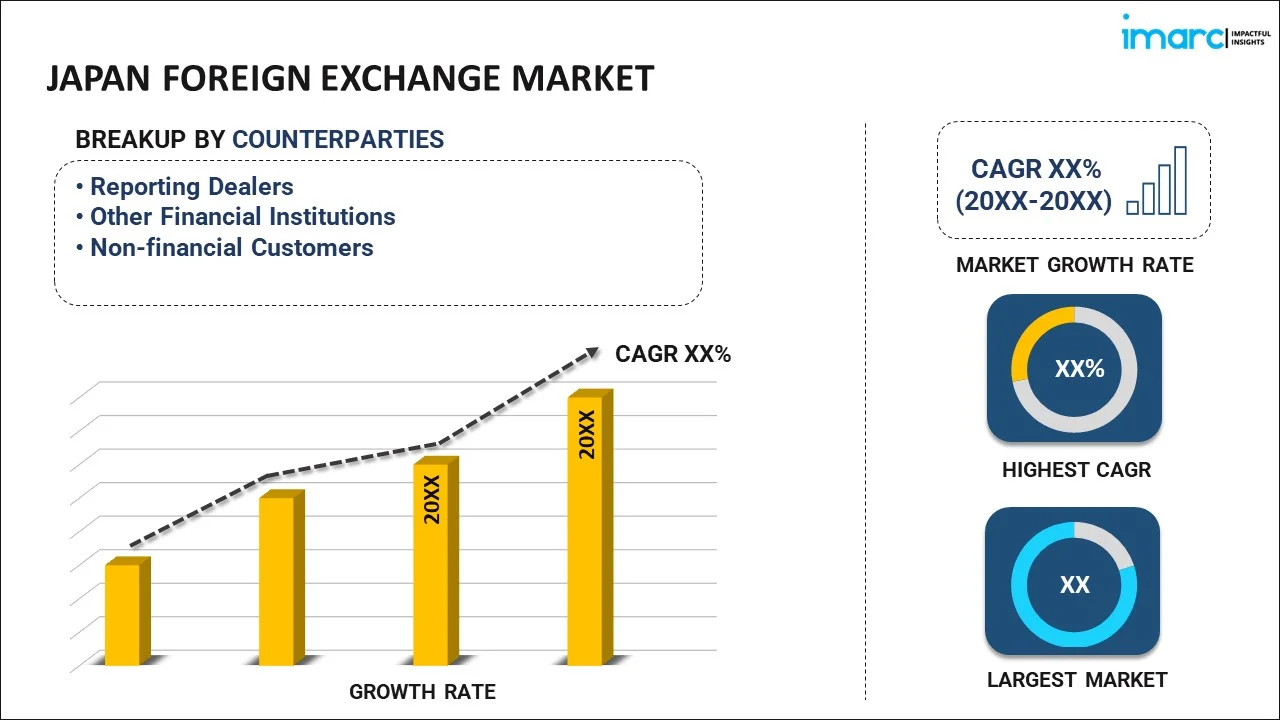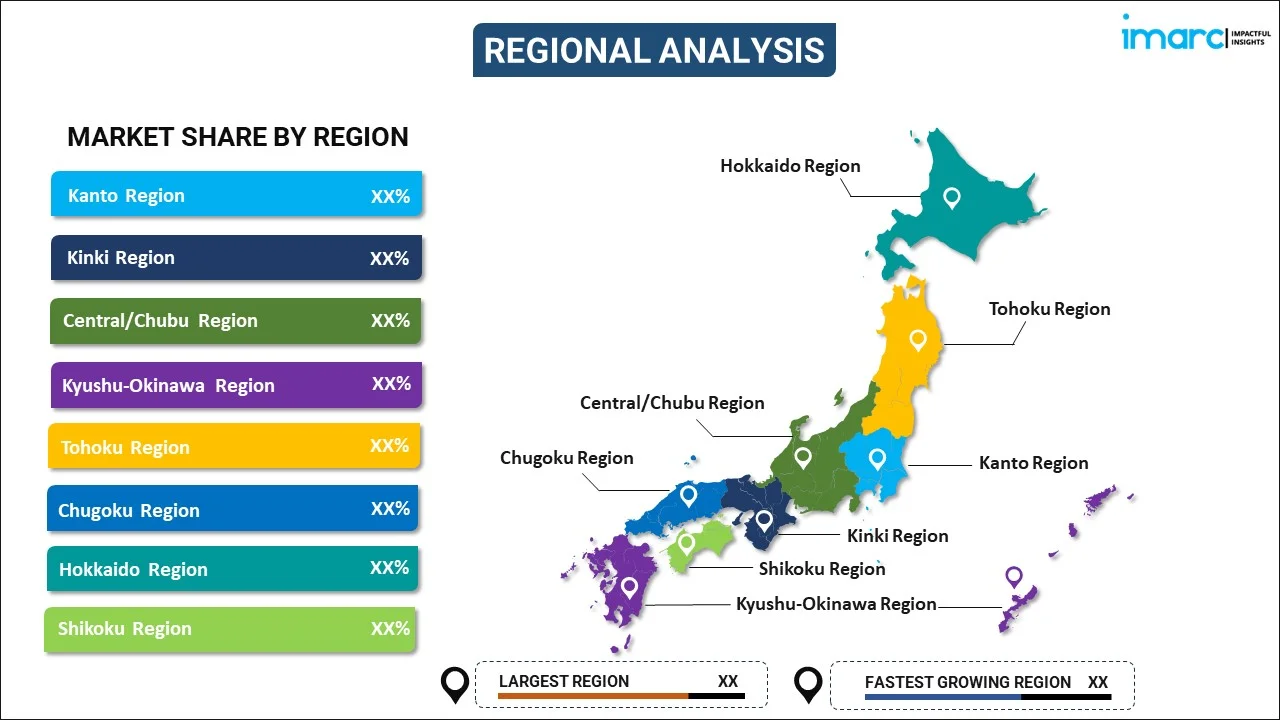
Japan Foreign Exchange Market Report by Counterparty (Reporting Dealers, Other Financial Institutions, Non-financial Customers), Type (Currency Swap, Outright Forward and FX Swaps, FX Options), and Region 2025-2033
Market Overview:
The Japan foreign exchange market size reached USD 55.2 Billion in 2024. Looking forward, IMARC Group expects the market to reach USD 111.9 Billion by 2033, exhibiting a growth rate (CAGR) of 8.2% during 2025-2033. The shifting consumer inclination toward currency trading, inflating disposable incomes, and higher interest rates of foreign exchange rates represent some of the key factors driving the market.
|
Report Attribute
|
Key Statistics
|
|---|---|
|
Base Year
|
2024 |
|
Forecast Years
|
2025-2033
|
|
Historical Years
|
2019-2024
|
| Market Size in 2024 | USD 55.2 Billion |
| Market Forecast in 2033 | USD 111.9 Billion |
| Market Growth Rate (2025-2033) | 8.2% |
The foreign exchange market, often referred to as the Forex market or FX market, is a global decentralized market where currencies are bought and sold. It is the largest and most liquid financial market in the world, with an average daily trading volume surpassing trillions of dollars. It facilitates the conversion of one currency into another for various purposes, including international trade, investment, tourism, and speculation. Participants in the foreign exchange market range from large financial institutions, such as banks and hedge funds, to individual retail traders. The market operates 24 hours a day, five days a week, across major financial centers worldwide, allowing continuous trading opportunities for participants in different time zones. The Forex exchange rates are determined by various factors, including interest rates, inflation rates, political stability, economic performance, and market sentiment. The market is characterized by high liquidity, which means that it is relatively easy to buy or sell currencies without significantly affecting exchange rates. As a result, foreign exchange is gaining immense traction among central banks, commercial banks, corporations, and individual traders across Japan who collectively contribute to the constant flow of buying and selling.
Japan Foreign Exchange Market Trends:
At present, monetary policy decisions by the Bank of Japan (BoJ), such as interest rates and quantitative easing, represents one of the key factors influencing the market growth in Japan. For instance, low-interest rates often lead to a weaker Yen, as investors seek higher returns elsewhere. Additionally, the Japanese government's fiscal policy, including its budgeting decisions and debt management, is another major growth-inducing factor. Besides this, the health and performance of Japan's financial markets, particularly the Tokyo Stock Exchange, has catalyzed the market growth. If the market performs well, it can attract foreign investment, thus increasing demand for the Yen currency, causing it to appreciate. Moreover, the state of the US economy and the USD/JPY rate is positively influencing the Japanese foreign exchange market due to the intertwined economic relationship between Japan and the US. Apart from this, the rising risk appetite among investors that can affect the Yen's value is propelling the market growth. High-risk appetite typically weakens the Yen as investors move toward riskier assets, whereas low-risk appetite strengthens it as investors seek safety. Other factors, including the shifting consumer inclination toward currency trading, inflating consumer disposable incomes, and higher interest rates of Forex rates, are also anticipated to drive the market further.
Japan Foreign Exchange Market Segmentation:
IMARC Group provides an analysis of the key trends in each segment of the Japan foreign exchange market report, along with forecasts at the country level for 2025-2033. Our report has categorized the market based on counterparty and type.
Counterparty Insights:

- Reporting Dealers
- Other Financial Institutions
- Non-financial Customers
The report has provided a detailed breakup and analysis of the Japan foreign exchange market based on the counterparty. This includes reporting dealers, other financial institutions, and non-financial customers.
Type Insights:
- Currency Swap
- Outright Forward and FX Swaps
- FX Options
A detailed breakup and analysis of the Japan foreign exchange market based on the type has also been provided in the report. This includes currency swap, outright forward and FX swaps, and FX options.
Regional Insights:

- Kanto Region
- Kinki Region
- Central/ Chubu Region
- Kyushu-Okinawa Region
- Tohoku Region
- Chugoku Region
- Hokkaido Region
- Shikoku Region
The report has also provided a comprehensive analysis of all the major regional markets, which include the Kanto region, Kinki region, Central/Chubu region, Kyushu-Okinawa region, Tohoku region, Chugoku region, Hokkaido region, and Shikoku region.
Competitive Landscape:
The report has also provided a comprehensive analysis of the competitive landscape in the Japan foreign exchange market. Competitive analysis such as market structure, key player positioning, top winning strategies, competitive dashboard, and company evaluation quadrant has been covered in the report. Also, detailed profiles of all major companies have been provided.
Japan Foreign Exchange Market Report Coverage:
| Report Features | Details |
|---|---|
| Base Year of the Analysis | 2024 |
| Historical Period | 2019-2024 |
| Forecast Period | 2025-2033 |
| Units | Billion USD |
| Scope of the Report | Exploration of Historical and Forecast Trends, Industry Catalysts and Challenges, Segment-Wise Historical and Predictive Market Assessment:
|
| Counterparties Covered | Reporting Dealers, Other Financial Institutions, Non-financial Customers |
| Types Covered | Currency Swap, Outright Forward and FX Swaps, FX Options |
| Regions Covered | Kanto Region, Kinki Region, Central/Chubu Region, Kyushu-Okinawa Region, Tohoku Region, Chugoku Region, Hokkaido Region, Shikoku Region |
| Customization Scope | 10% Free Customization |
| Post-Sale Analyst Support | 10-12 Weeks |
| Delivery Format | PDF and Excel through Email |
Key Questions Answered in This Report:
- How has the Japan foreign exchange market performed so far and how will it perform in the coming years?
- What has been the impact of COVID-19 on the Japan foreign exchange market?
- What is the breakup of the Japan foreign exchange market on the basis of the counterparty?
- What is the breakup of the Japan foreign exchange market on the basis of the type?
- What are the various stages in the value chain of the Japan foreign exchange market?
- What are the key driving factors and challenges in the Japan foreign exchange market?
- What is the structure of the Japan foreign exchange market and who are the key players?
- What is the degree of competition in the Japan foreign exchange market?
Key Benefits for Stakeholders:
- IMARC’s report offers a comprehensive quantitative analysis of various market segments, historical and current market trends, market forecasts, and dynamics of the Japan foreign exchange market from 2019-2033.
- The research study provides the latest information on the market drivers, challenges, and opportunities in the Japan foreign exchange market.
- Porter's five forces analysis assist stakeholders in assessing the impact of new entrants, competitive rivalry, supplier power, buyer power, and the threat of substitution. It helps stakeholders to analyze the level of competition within the Japan foreign exchange industry and its attractiveness.
- Competitive landscape allows stakeholders to understand their competitive environment and provides an insight into the current positions of key players in the market.
Need more help?
- Speak to our experienced analysts for insights on the current market scenarios.
- Include additional segments and countries to customize the report as per your requirement.
- Gain an unparalleled competitive advantage in your domain by understanding how to utilize the report and positively impacting your operations and revenue.
- For further assistance, please connect with our analysts.
 Inquire Before Buying
Inquire Before Buying
 Speak to an Analyst
Speak to an Analyst
 Request Brochure
Request Brochure
 Request Customization
Request Customization




.webp)




.webp)












